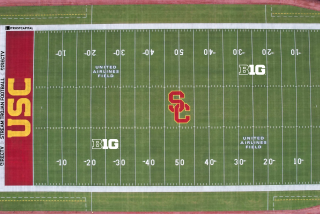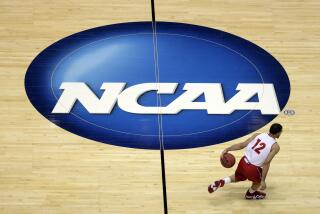NCAA Wants to Say When to the Beer Commercials
“Know when to say when.”
The beautiful people in beer ads will be saying this more often if Dick Schultz, the executive director of the National Collegiate Athletic Association, has his say.
The NCAA, currently negotiating with television for the rights to broadcast basketball and other sports championships, has told the networks the only beer advertisements that can be shown must be those that promote responsible consumption or drug education.
This point was labeled non-negotiable in the proposal the NCAA sent to the networks in October. Whether that was indeed the case should be known by Thanksgiving, when the NCAA is expected to announce the winning network.
Whatever the final restrictions on beer advertising, it will be a shorter step than some predicted Schultz would take. It was thought Schultz, offended by the inconsistency of anti-drug ads back-to-back with beer ads, might ban beer commercials.
Even so, the networks are not happy about this restriction, and neither are the beer companies. But Schultz sits at the apex of this triangle. The networks need this sports package -- with the Final Four as its centerpiece -- and so do the beer companies.
“The NCAA is in a no-lose situation,” said a source at one of the networks. (Neither the networks, the beer companies nor the NCAA would talk on the record while these negotiations are under way.)
“The networks are in a more competitive situation than they have ever been. Only a half-dozen sports properties are this visible. And the NCAAs (the basketball championships) are one of those properties that allows you to win a sweeps period (viewer ratings).”
The beer companies are locked in this dance, too.
“As long as beer can possibly be involved in sports, they are going to be,” said John McManus, staff reporter for Ad Week, who covers the beer industry.
“It is going to take wild horses to drag them out. It is the only way they can reach the young male demographics they want.”
For at least 12 years, the NCAA has required the networks to run drug-education ads on every NCAA-event telecast. The television contract set to expire after the Final Four basketball tournament in the spring limited beer ads to 90 seconds every hour.
Under any new agreement, the content of the ads will be strictly limited to the “know when to say when” and “don’t drive drunk” messages.
“We are sending mixed messages to our viewers by showing a drug-education spot followed by a beer ad,” said Shultz in a newspaper interview earlier this year.
“We’ve got to do something about this problem. High school federations and others say there are 3 to 4 million alcoholics under drinking age in this country, and many of those kids watch our programs.”
It appears Schultz’s proposal for responsible-consumption-only ads has support among NCAA member institutions, but not without hesitation. The proposal was approved by a five-man negotiating committee. Jack Lengyel, athletic director at the Naval Academy and president of the National Collegiate Directors of Athletics, said his group is behind Schultz.
“We think Dick Schultz is tracking properly on this. To have a substance-abuse program and then promote alcohol when alcohol is the problem on campuses is incongruous,” Lengyel said.
But there is a level of concern among athletic directors. Might it also become incongruous and a mixed message to have financial support for college sports activities from local beer distributors?
Will sanitized television ads eventually mean no sponsorship for conference basketball tournaments, no commercials for coach’s radio shows and no money to print wallet-size schedules?
“I think athletic directors can find other means of support,” said Lengyel.
Loyola Athletic Director Tom Brennan said, “We have had Budweiser’s support for our soccer team for 14 years. Anheuser-Busch has endowed a faculty chair here. But whether or not a beer company can support Loyola is not going to make or break our athletic program.”
The networks have argued the beer companies are the engine that drive this gravy train. The breweries simply won’t pay top dollar for a 30-second spot that can be used only for a sanitized ad, the networks contend.
The breweries alternate with the auto companies for the top spot among sports advertisers, spending $200 million a year. And there is no other advertiser waiting in the wings to shoulder that kind of advertising burden, the networks argue. Without their support, the networks say they can’t offer top dollar for the NCAA’s package.
“Our rights fees would plummet without beer ads,” said Jerry Dominus, vice president for sales for CBS, in an interview before the negotiations began.
“It would be impossible to replace (the revenue) for the foreseeable future. Our ability to pay is at least partially a function of our level of support.”
CBS spent $165 million on its last three-year contract with the NCAA. Beer ads represented about $36 million in network revenue during that contract, a little less than 22 percent.
The National Association of Broadcasters, which represents more than 5,000 radio stations and 900 television stations, has asked its member stations to contact their local college officials and urge them to lobby the NCAA against any restriction.
NAB President Edward Fritts said this type of restriction against the advertising of a legal product “threatens to set a dangerous precedent which would have potentially serious economic repercussions for broadcasters.
“Should such restrictions be duplicated with other sports, we would see millions of dollars of ad revenue flow out of sports broadcasting.”
The beer industry has launched its own lobbying campaign against this move by the NCAA, though its executives refused to be interviewed for this article. Industry executives have met privately with Schultz and sent him letters.
James Sanders, president of the Beer Institute in Washington, is willing to state the industry’s feelings publicly.
“The beer people are very willing to devote some of their very expensive time to public-safety messages,” Sanders said. But, he said, not to the tune of a 30-second spot during the Final Four.
“There is some widespread feeling in the NCAA that the executive committee is not going in the right direction, that a little hysteria has taken over there,” Sanders said.
“Mr. Schultz may say it is not negotiable. It is unfortunate to be that rigid. We’ll have to make our decision if it comes to that.”
If that is a threat, it may be an idle one. Beer companies need to reach the audiences that watch sporting events -- all those 21- to 44-year-old men who grab a cold one and the remote control on weekend afternoons.
“It is a demographic base that is effective for us,” said Bill Stolberg, who works in the St. Louis public relations firm that represents Anheuser-Busch. He declined to discuss the NCAA restrictions, but talked in general terms about beer advertising and sports.
“It’s a very valid argument that the vast majority of the people on the other side of the TV (during sports broadcasts) are beer consumers.”
Stolberg said industry studies have shown beer ads do not increase consumption, recruit new beer drinkers or promote abuse.
“It does convince or encourage a consumer over 21 who has already made a decision to drink beer to choose our product,” he said.
At the suggestion that beer ads on college sports broadcasts should only be of a responsible type, Stolberg responded, “We would argue that our regular beer ads are responsible.”
More to Read
Go beyond the scoreboard
Get the latest on L.A.'s teams in the daily Sports Report newsletter.
You may occasionally receive promotional content from the Los Angeles Times.










